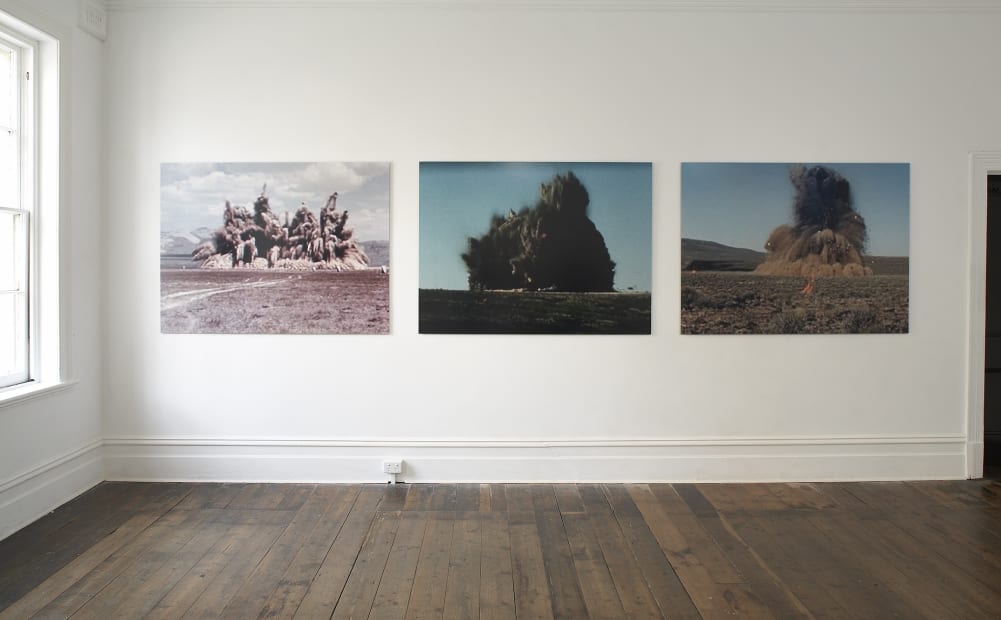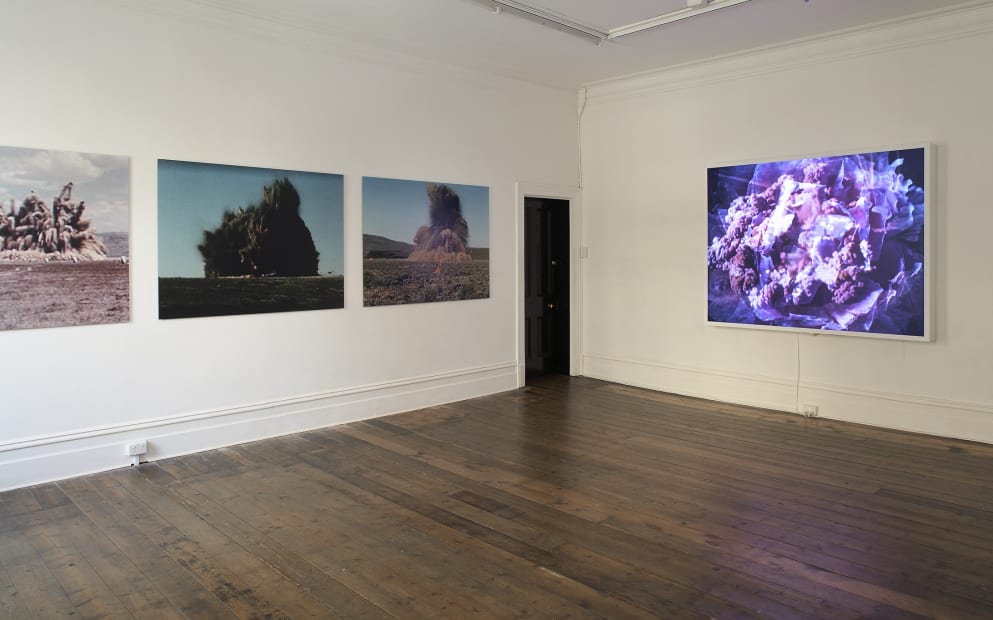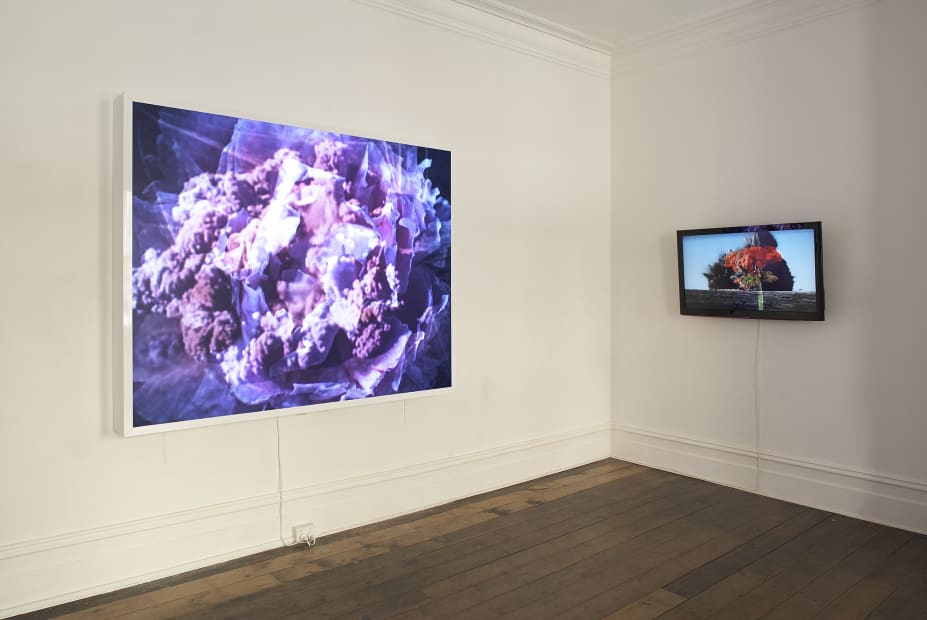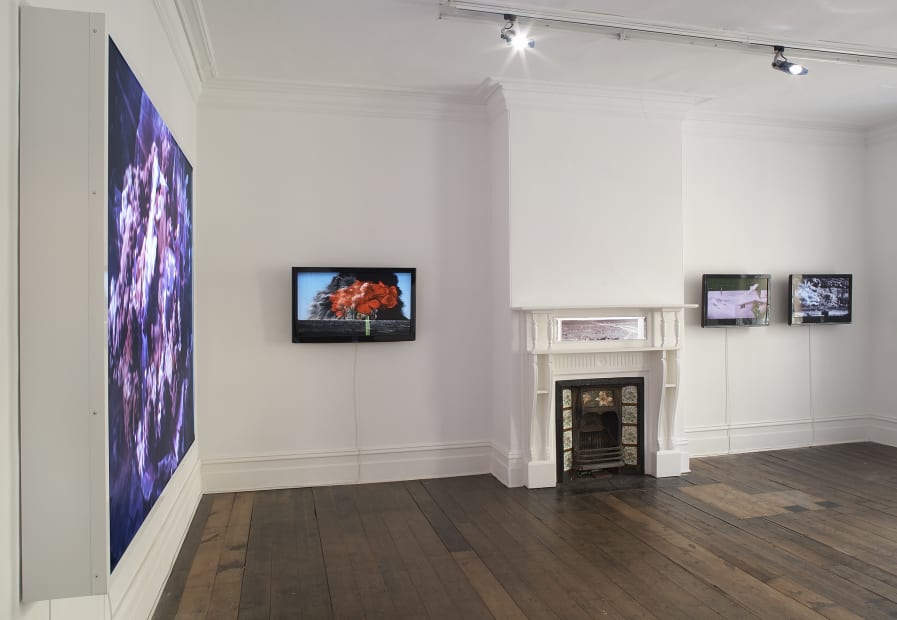Kit Wise: Explosion
Flooding back
Kit Wise's video Explosion (Operation Cue, 1955) is a strange nocturnal landscape in endless motion - part lunar landscape, part movie set, part night-vision military surveillance footage. A building explodes and disappears into its own cloud - enveloped by the detritus of its own obliteration - only to re-form itself into a different building, which in turn explodes, disappearing into another field of pulverized building. In this sequence of loop after loop, gravity seems to give way. The matter of the building dissolves into the matter of the picture, into a play between the scratched surface of the film and its digitized artefacts. The picture is flooded by itself.
Explosion (Operation Cue, 1955) has been created using short fragments from Operation Cue, a 1955 documentary (revised in 1964), which, like much of the found footage Wise has used in recent work, is available on open source web-based video archives. The original documentary was produced to educate the general population about the effects of nuclear blasts and shows a series of nuclear bomb test explosions in the Nevada desert. The buildings which endlessly appear and disappear before us in Explosion (Operation Cue, 1955) were constructed for the very purpose of their obliteration and for the filming of this obliteration. They express an important part of photography, its relationship to violence (photography's relationship to military surveillance in which being photographed precedes and/or coincides with being bombed) and the fraught mutual co-dependence with ephemerality (photography's conflicted centrality to performance art, or more generally, to our understanding of our own mortality). Explosion (Operation Cue, 1955) enacts photography's ability to capture what time destroys, only in a violently accelerated cycle. And this enactment is repeated with the same frozen endlessness which, more than ever in the age of the digitized image, sets the temporal space of the image against the finiteness of our living.
All three of the video works in this exhibition are striking for their beauty. Acts of great violence are slowed and looped into spaces of strange reverie, a kind of hypnotic allure. What are we to make of this beauty? As I watched Explosion (Operation Cue, 1955) for the first time I found myself recalling Wise's video installation at Linden in 2008, Natural disaster. This work consisted of footage (again taken from open source web-based video archives) shot by survivors of the 2004 Boxing Day Tsunami. In these low res sequences, we saw the rush of water engulfing the surroundings of the person shooting the footage. Wise intensified the effect of this inundation by installing mirrors around his video projection, producing psychedelic mandala-like pixellated abstractions as the Tsunami swept through the image. The engulfing of the surroundings by the tsunami also became the engulfing of the figurative image, which dissolved into fields of moving pixels and artefact, a digitized surface patterning. Whereas this spectacle of ornamentation intensified the curious distance with which we regard these faraway disasters through its sheer beauty, the work's sound - the voices of horrified bystanders watching the water sweeping away everything before them - grounded the work in the horror of that event. Importantly, these sounds made us engage this horror not through vision, but through listening, imagining. The video images dissolved figuration into a mobile, baroque field of pixellation. Sound reinstated the body, the physicality of that experience. The horror of Natural disaster was not just its literal content, but implicating us in a contemporary dysfunction of the senses, entwining pleasure (in looking) and the suffering of others (through listening). In a way that reminded me of the relationship between Michelangelo's The Deluge (on the ceiling) and The Last Judgement (on the end wall) in the Sistine Chapel - in both images the illusionistic space of the fresco is engulfed by a monochrome ground, figuring the idea of the flood through the physical surface of the image - Natural disaster used a radically shallow pictorial space as a space of moral reckoning. And this reckoning, rather than metaphysical or teleological in nature, was focused on the image itself and its relationship to the real.
This relationship between the space of the image and our understanding of the real is what animates our encounter with Explosion, this exhibition of Wise's new work. In Explosion (Project Dugout, 1960) - a short loop taken from Project Dugout, a film produced by the University of California in 1960 presenting research into the effects of underground explosions - a landscape ascends high into the sky then descends again. As we watch this video, the loop of this vertical movement accumulates in us as a pleasurable sensation of weightlessness, an aestheticizing of that event that also threatens to become an anaesthetizing to its violence. It is a vertical movement divested of any moral encoding. No Last Judgement in these comings and goings up and down the picture plane. Explosion (Geranium) intensifies this aestheticising, overlaying time-lapse footage (from Getty images) of a geranium blooming and documentary footage of a test explosion in the desert. The two processes intermingle visually, and also sexualise one another (in a way that is reminiscent of the visually euphemistic tradition of fireworks in cinema). Explosion, like the endless looping of Explosion (Operation Cue, 1955), draws us away from the reality of nuclear destruction and towards the surface of the image, the movement of this surface, its slow underwater-like grace. In all three videos, the image empties its subject.
Andy Warhol's Car Crash paintings are great images of horror, not as realist paintings, but as emptied-out surfaces. They work upon the gulf between the image and its subject. Their horror is not that that they show something we do not know, but in opening our encounter to this gulf. As Hal Foster has eloquently argued, the real 'returns' through the surfaces of these paintings, through their screens, as a punctum. Wise's show might be considered in relation to Warhol, a Youtube-age refiguring of Warhol's peculiarly powerful way of mobilizing waning into a form of horror in itself. Wise's aestheticising - or more precisely the very intense way that we find ourselves attending to the surface of his videos - creates a kind of screen for something which cannot be shown, which opens out behind the pleasure of these images. What that 'something' might be is a bleakness within this work, or at least a condition from which the work refuses to redeem us. But pleasure in these works is not just a pathway into bleakness. It flows in part from the beauty of that very simple act of finding things - in this case pieces of footage - and deploying them with the utmost economy, transforming them into art works, into forms of intense fascination that demand and reward the process of looking. It is the act of imagination which effects this transformation, an act of gentle creativity towards the world that is also a counterpoint to the violent enormity of these explosions.
Tom Nicholson, August 2010
Tom Nicholson is an artist who lives in Melbourne.










